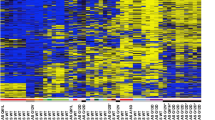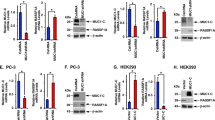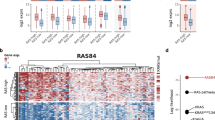Abstract
RASSF2 is a recently identified member of a class of novel tumour suppressor genes, all containing a ras-association domain. RASSF2 resides at 20p13, a region frequently lost in human cancers. In this report we investigated methylation status of the RASSF2 promoter CpG island in a series of breast, ovarian and non-small cell lung cancers (NSCLC). RASSF2 was frequently methylated in breast tumour cell lines (65%, 13/20) and in primary breast tumours (38%, 15/40). RASSF2 expression could be switched back on in methylated breast tumour cell lines after treatment with 5′-aza-2′deoxycytidine. RASSF2 was also frequently methylated in NSCLC tumours (44%, (22/50). The small number of corresponding normal breast and lung tissue DNA samples analysed were unmethylated. We also did not detect RASSF2 methylation in ovarian tumours (0/17). Furthermore no mutations were found in the coding region of RASSF2 in these ovarian tumours. We identified a highly conserved putative bipartite nuclear localization signal (NLS) and demonstrated that endogenous RASSF2 localized to the nucleus. Mutation of the putative NLS abolished the nuclear localization. RASSF2 suppressed breast tumour cell growth in vitro and in vivo, while the ability of NLS-mutant RASSF2 to suppress growth was much diminished. Hence we demonstrate that RASSF2 has a functional NLS that is important for its tumour suppressor gene function. Our data from this and a previous report indicate that RASSF2 is frequently methylated in colorectal, breast and NSCLC tumours. We have identified RASSF2 as a novel methylation marker for multiple malignancies and it has the potential to be developed into a valuable marker for screening several cancers in parallel using promoter hypermethylation profiles.
This is a preview of subscription content, access via your institution
Access options
Subscribe to this journal
Receive 50 print issues and online access
$259.00 per year
only $5.18 per issue
Buy this article
- Purchase on Springer Link
- Instant access to full article PDF
Prices may be subject to local taxes which are calculated during checkout




Similar content being viewed by others
References
Agathanggelou A, Cooper WN, Latif F . (2005). Role of the ras-association domain family 1 tumor suppressor gene in human cancers. Cancer Res 65: 3497–3508.
Agathanggelou A, Honorio S, Macartney DP, Martinez A, Dallol A, Radar J et al. (2001). Methylation associated inactivation of RASSF1A from region 3p21.3 in lung, breast and ovarian tumours. Oncogene 20: 1509–1518.
Akino K, Toyota M, Suzuki H, Mita H, Sasaki Y, Ohe-Toyota M et al. (2005). The Ras effector RASSF2 is a novel tumor-suppressor gene in human colorectal cancer. Gastroenterology 129: 156–169.
Allen NP, Donninger H, Vos MD, Eckfeld K, Hesson L, Gordon L et al. (2007). RASSF6 is a novel member of the RASSF family of tumor suppressors. Oncogene; e-pub ahead of print: 2 April 2007.
Burbee DG, Forgacs E, Zochbauer-Muller S, Shivakumar L, Fong K, Gao BN et al. (2001). Epigenetic inactivation of RASSF1A in lung and breast cancers and malignant phenotype suppression. J Natl Cancer Inst 93: 691–699.
Cox AD, Der CJ . (2003). The dark side of Ras: regulation of apoptosis. Oncogene 22: 8999–9006.
Dallol A, Agathanggelou A, Tommasi S, Pfeifer GP, Maher ER, Latif F . (2005). Involvement of the RASSF1A tumor suppressor gene in controlling cell migration. Cancer Res 65: 7653–7659.
Dammann R, Li C, Yoon JH, Chin PL, Bates S, Pfeifer GP . (2000). Epigenetic inactivation of a RAS association domain family protein from the lung tumour suppressor locus 3p21.3. Nat Genet 25: 315–319.
Eckfeld K, Hesson L, Vos MD, Bieche I, Latif F, Clark GJ . (2004). RASSF4/AD037 is a potential ras effector/tumor suppressor of the RASSF family. Cancer Res 64: 8688–8693.
Guo C, Tommasi S, Liu L, Yee JK, Dammann R, Pfeifer GP . (2007). RASSF1A is part of a complex similar to the Drosophila Hippo/Salvador/Lats tumor-suppressor network. Curr Biol 17: 700–705.
Hesson L, Bieche I, Krex D, Criniere E, Hoang-Xuan K, Maher ER et al. (2004). Frequent epigenetic inactivation of RASSF1A and BLU genes located within the critical 3p21.3 region in gliomas. Oncogene 23: 2408–2419.
Hesson LB, Cooper WN, Latif F . (2007). Evaluation of the 3p21.3 tumour-suppressor gene cluster. Oncogene; e-pub ahead of print: 28 May 2007.
Hesson L, Dallol A, Minna JD, Maher ER, Latif F . (2003). NORE1A, a homologue of RASSF1A tumour suppressor gene is inactivated in human cancers. Oncogene 22: 947–954.
Hesson LB, Wilson R, Morton D, Adams C, Walker M, Maher ER et al. (2005). CpG island promoter hypermethylation of a novel Ras-effector gene RASSF2A is an early event in colon carcinogenesis and correlates inversely with K-ras mutations. Oncogene 24: 3987–3994.
Irimia M, Fraga MF, Sanchez-Cespedes M, Esteller M . (2004). CpG island promoter hypermethylation of the Ras-effector gene NORE1A occurs in the context of a wild-type K-ras in lung cancer. Oncogene 23: 8695–8699.
Kashuba VI, Li JF, Wang FL, Senchenko VN, Protopopov A, Malyukova A et al. (2004). RBSP3 (HYA22) is a tumor suppressor gene implicated in major epithelial malignancies. Proc Natl Acad Sci USA 101: 4906–4911.
Lambros MB, Fiegler H, Jones A, Gorman P, Roylance RR, Carter NP et al. (2005). Analysis of ovarian cancer cell lines using array-based comparative genomic hybridization. J Pathol 205: 29–40.
Lerman MI, Minna JD . (2000). The 630-kb lung cancer homozygous deletion region on human chromosome 3p21.3: identification and evaluation of the resident candidate tumor suppressor genes. Cancer Res 60: 6116–6133.
Malumbres M, Barbacid M . (2003). RAS oncogenes: the first 30 years. Nat Rev Cancer 3: 459–465.
Park HW, Kang HC, Kim IJ, Jang SG, Kim K, Yoon HJ et al. (2007). Correlation between hypermethylation of the RASSF2A promoter and K-ras/BRAF mutations in microsatellite-stable colorectal cancers. Int J Cancer 120: 7–12.
Protopopov AI, Li J, Winberg G, Gizatullin RZ, Kashuba VI, Klein G et al. (2002). Human cell lines engineered for tetracycline-regulated expression of tumor suppressor candidate genes from a frequently affected chromosomal region, 3p21. J Gene Med 4: 397–406.
Robbins J, Dilworth SM, Laskey RA, Dingwall C . (1991). Two interdependent basic domains in nucleoplasmin nuclear targeting sequence: identification of a class of bipartite nuclear targeting sequence. Cell 64: 615–623.
Rommel C, Hafen E . (1998). Ras—a versatile cellular switch. Curr Opin Genet Dev 8: 412–418.
Schubbert S, Bollag G, Shannon K . (2007). Deregulated Ras signaling in developmental disorders: new tricks for an old dog. Curr Opin Genet Dev 17: 15–22.
Shields JM, Pruitt K, McFall A, Shaub A, Der CJ . (2000). Understanding Ras: ‘it ain't over ‘til it's over’. Trends Cell Biol 10: 147–154.
Tommasi S, Dammann R, Jin SG, Zhang XF, Avruch J, Pfeifer GP . (2002). RASSF3 and NORE1: identification and cloning of two human homologues of the putative tumor suppressor gene RASSF1. Oncogene 21: 2713–2720.
Tommasi S, Dammann R, Zhang ZQ, Wang Y, Liu LM, Tsark WM et al. (2005). Tumor susceptibility of Rassf1a knockout mice. Cancer Res 65: 92–98.
van der Weyden L, Tachibana KK, Gonzalez MA, Adams DJ, Ng BL, Petty R et al. (2005). The RASSF1A isoform of RASSF1 promotes microtubule stability and suppresses tumorigenesis. Mol Cell Biol 25: 8356–8367.
Vos MD, Ellis CA, Elam C, Ulku AS, Taylor BJ, Clark GJ . (2003). RASSF2 is a novel K-Ras-specific effector and potential tumor suppressor. J Biol Chem 278: 28045–28051.
Yoon JH, Damman R, Pfeifer GP . (2001). Hypermethylation of the CpG island of the RASSF1A gene in ovarian and renal cell carcinomas. Int J Cancer 94: 212–217.
Zhang Z, Sun D, Van do N, Tang A, Hu L, Huang G . (2007). Inactivation of RASSF2A by promoter methylation correlates with lymph node metastasis in nasopharyngeal carcinoma. Int J Cancer 120: 32–38.
Acknowledgements
Research in FL laboratory funded in part by Breast Cancer Campaign, Cancer Research UK, Association for International Cancer Research and Birmingham Children's Hospital Research Foundation. ERZ was supported by research grants from the Swedish Cancer Society, Swedish Research Council, Swedish Foundation for International Cooperation in Research and Higher Education (STINT), Swedish Institute, Royal Swedish Academy of Sciences, INTAS and Karolinska Institute.
Author information
Authors and Affiliations
Corresponding author
Rights and permissions
About this article
Cite this article
Cooper, W., Dickinson, R., Dallol, A. et al. Epigenetic regulation of the ras effector/tumour suppressor RASSF2 in breast and lung cancer. Oncogene 27, 1805–1811 (2008). https://doi.org/10.1038/sj.onc.1210805
Received:
Revised:
Accepted:
Published:
Issue Date:
DOI: https://doi.org/10.1038/sj.onc.1210805
Keywords
This article is cited by
-
Tumor suppressor C-RASSF proteins
Cellular and Molecular Life Sciences (2018)
-
Comparative Modeling, Molecular Docking, and Revealing of Potential Binding Pockets of RASSF2; a Candidate Cancer Gene
Interdisciplinary Sciences: Computational Life Sciences (2017)
-
Prognostic importance of RASSF2 expression in patients with gastric cancer who had undergone radical gastrectomy
Clinical and Translational Oncology (2016)
-
Aberrant hypermethylation of RASSF2 in tumors and peripheral blood DNA as a biomarker for malignant progression and poor prognosis of esophageal squamous cell carcinoma
Clinical & Experimental Metastasis (2016)
-
RASSF2 hypermethylation is present and related to shorter survival in squamous cervical cancer
Modern Pathology (2013)



